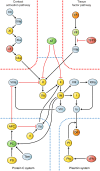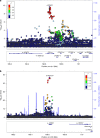Profiling of the plasma proteome across different stages of human heart failure
- PMID: 31862877
- PMCID: PMC6925199
- DOI: 10.1038/s41467-019-13306-y
Profiling of the plasma proteome across different stages of human heart failure
Abstract
Heart failure (HF) is a major public health problem characterized by inability of the heart to maintain sufficient output of blood. The systematic characterization of circulating proteins across different stages of HF may provide pathophysiological insights and identify therapeutic targets. Here we report application of aptamer-based proteomics to identify proteins associated with prospective HF incidence in a population-based cohort, implicating modulation of immunological, complement, coagulation, natriuretic and matrix remodeling pathways up to two decades prior to overt disease onset. We observe further divergence of these proteins from the general population in advanced HF, and regression after heart transplantation. By leveraging coronary sinus samples and transcriptomic tools, we describe likely cardiac and specific cellular origins for several of the proteins, including Nt-proBNP, thrombospondin-2, interleukin-18 receptor, gelsolin, and activated C5. Our findings provide a broad perspective on both cardiac and systemic factors associated with HF development.
Conflict of interest statement
The authors declare no competing interests.
Figures





Similar articles
-
Aptamer-Based Proteomic Platform Identifies Novel Protein Predictors of Incident Heart Failure and Echocardiographic Traits.Circ Heart Fail. 2020 May;13(5):e006749. doi: 10.1161/CIRCHEARTFAILURE.119.006749. Epub 2020 May 15. Circ Heart Fail. 2020. PMID: 32408813 Free PMC article.
-
NT-proBNP and CA 125 levels are associated with increased pro-inflammatory cytokines in coronary sinus serum of patients with chronic heart failure.Cytokine. 2018 Nov;111:13-19. doi: 10.1016/j.cyto.2018.07.037. Epub 2018 Aug 8. Cytokine. 2018. PMID: 30098475 Clinical Trial.
-
Soluble CD146 Is a Novel Marker of Systemic Congestion in Heart Failure Patients: An Experimental Mechanistic and Transcardiac Clinical Study.Clin Chem. 2017 Jan;63(1):386-393. doi: 10.1373/clinchem.2016.260471. Epub 2016 Oct 25. Clin Chem. 2017. PMID: 28062630 Clinical Trial.
-
Natriuretic and Inflammatory Biomarkers as Risk Predictors of Heart Failure in Middle-Aged Men From the General Population: A 21-Year Follow-Up.J Card Fail. 2018 Sep;24(9):594-600. doi: 10.1016/j.cardfail.2018.07.005. Epub 2018 Jul 23. J Card Fail. 2018. PMID: 30048772
-
Emerging Affinity-Based Proteomic Technologies for Large-Scale Plasma Profiling in Cardiovascular Disease.Circulation. 2017 Apr 25;135(17):1651-1664. doi: 10.1161/CIRCULATIONAHA.116.025446. Circulation. 2017. PMID: 28438806 Free PMC article. Review.
Cited by
-
Serum Matrix Metalloproteinases and Left Atrial Remodeling-The Hoorn Study.Int J Mol Sci. 2020 Jul 13;21(14):4944. doi: 10.3390/ijms21144944. Int J Mol Sci. 2020. PMID: 32668720 Free PMC article.
-
Multifaceted role of cardiovascular biomarkers.Indian Heart J. 2023 Mar-Apr;75(2):91-97. doi: 10.1016/j.ihj.2023.01.011. Epub 2023 Feb 1. Indian Heart J. 2023. PMID: 36736458 Free PMC article. Review.
-
Proteomic Mediators of Overall Cardiovascular Health on All-Cause Mortality.Nutrients. 2023 Feb 3;15(3):781. doi: 10.3390/nu15030781. Nutrients. 2023. PMID: 36771486 Free PMC article.
-
Identification of Independent and Communal Differentially Expressed Genes as Well as Potential Therapeutic Targets in Ischemic Heart Failure and Non-Ischemic Heart Failure.Pharmgenomics Pers Med. 2021 Jun 14;14:683-693. doi: 10.2147/PGPM.S313621. eCollection 2021. Pharmgenomics Pers Med. 2021. PMID: 34163213 Free PMC article.
-
Emerging Technologies and Future Directions in Interorgan Crosstalk Cardiometabolic Research.Circ Res. 2025 May 23;136(11):1494-1506. doi: 10.1161/CIRCRESAHA.125.325515. Epub 2025 May 22. Circ Res. 2025. PMID: 40403107 Free PMC article. Review.
References
-
- Jessup M, Brozena S. Heart failure. N. Engl. J. Med. 2003;348:2007–2018. - PubMed
-
- Braunwald E. Biomarkers in heart failure. N. Engl. J. Med. 2008;358:2148–2159. - PubMed
-
- Swedberg K, Eneroth P, Kjekshus J, Wilhelmsen L. Hormones regulating cardiovascular function in patients with severe congestive heart failure and their relation to mortality. CONSENSUS Trial Study Group. Circulation. 1990;82:1730–1736. - PubMed
Publication types
MeSH terms
Substances
Grants and funding
LinkOut - more resources
Full Text Sources
Other Literature Sources
Medical
Molecular Biology Databases
Research Materials
Miscellaneous

